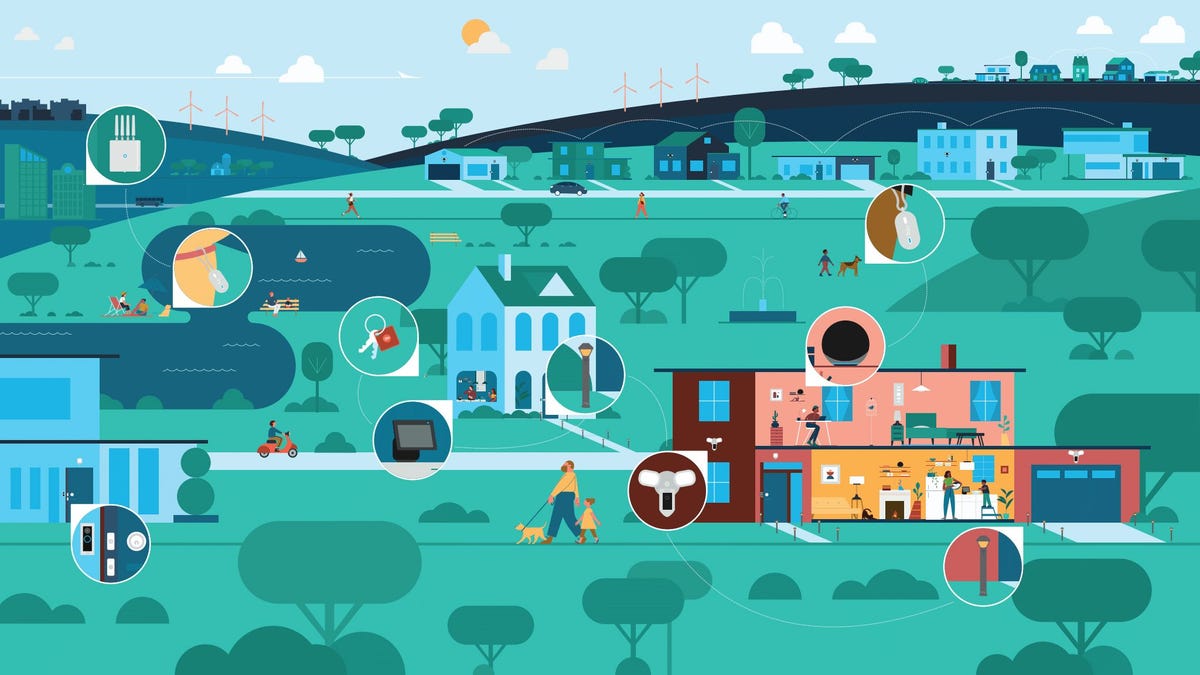 Why You Can Trust CNET
Why You Can Trust CNET Amazon Sidewalk expands beyond homes to build a commercial internet of things
A new, dedicated Sidewalk bridge will bring farms, factories and other nonresidential zones online with Amazon's long-range, low-power IoT network.

Amazon Sidewalk is a long-range, low-power IoT network that uses Bluetooth and LoRa radios, which are built into Echo and Ring devices, to connect devices with Amazon's cloud when they're beyond the reach of traditional home networks. The pitch was meant to leverage the connected gadgets in peoples' homes to keep things like Tile trackers and outdoor smart lights online, no matter where they might be. But relying on homes that opt in creates some obvious coverage gaps in rural areas, industrial regions and other places where the sidewalk ends.
Now, Amazon is introducing a new gadget designed to help fill those gaps. Dubbed the Amazon Sidewalk Bridge Pro by Ring and intended for farms, factories and other nonresidential settings, the Bridge Pro is a dedicated device housing the radios needed to relay Sidewalk's signals to the cloud. Rather than targeting consumers, who can already turn Sidewalk on via their Echo smart speakers and Ring cameras, Amazon is seeking to partner with industries and organizations beyond the reach of the current network.
With a weatherized design intended for potential outdoor use, the Sidewalk Bridge Pro is capable of sending and receiving device data at distances of up to 5 miles, well exceeding the range of the radios included with select Echo and Ring devices. Amazon isn't setting a price for the gadget, but is rather planning to explore proof-of-concept partnerships on a case-by-case basis.
The Amazon Sidewalk Bridge Pro by Ring.
One early partner is the University Technology Office at Arizona State University, which plans to install the devices atop the blue light poles used as emergency stations across the Tempe campus. From there, the bridges will help relay data from environmental sensors used by ASU faculty researchers while providing better IoT connectivity for compatible devices in the area.
"Exploring sustainable and long-term solutions plays a critical role in advancing our smart technology initiatives, both on campus and within the community," said Bobby Gray, University Technology Office's director of Digital Transformation at ASU. "Our goal is to deploy and test Amazon Sidewalk Bridge Pro to bring smart solutions, like those fitted to the blue light poles, to campus at scale and lower costs."
In another partnership, Amazon collaborated with Thingy, the makers of an outdoor air quality sensor meant to track wildfires. Better connectivity with Sidewalk servers should help those devices relay critical information about forest conditions to help guard against potentially catastrophic fires.
A Thingy air quality sensor intended to help track wildfires before they become catastrophic. Amazon Sidewalk's new bridge will help remote devices like these to send and receive data.
"We designed Thingy AQ for very remote locations where power efficiency and range were critical for fire ground operations, and have been using LoRa since day one," said Thingy CEO and co-founder Scott Waller. "Amazon Sidewalk Bridge Pro brings us the power of LoRa in a massive number of needed locations, easy integration with our existing applications in AWS, and trusted security for the devices and applications."
The expansion of Sidewalk's coverage map is obviously key for Amazon as it seeks to compete in the evolving IoT landscape, as well. Long-range connections are a growing use case for the smart home and for modernized industrial and agricultural applications, and Amazon seeks to ensure that its technology and AWS servers continue to play a central role. There are also clear potential benefits for Amazon's home delivery operations, especially as it continues to experiment with delivery drones.
Amazon wouldn't comment on potential in-house use cases for Sidewalk, but it will need to balance such opportunities against concerns about privacy and security that have persisted since the service was first introduced in 2019. For starters, the feature is still enabled by default on Echo and Ring devices, meaning that users need to choose to opt out if they don't want their home's gadgets connecting other people's devices to Amazon's cloud, and using a tiny bit of their home network's bandwidth in the process. That said, Community Finding, an additional feature that shares the approximate location of your home when another user is trying to find a Tile tracker or other Sidewalk device lost nearby, requires users to opt in first.
Forrester analyst Jeff Pollard described some of the broader privacy concerns in an interview with CNET shortly after Sidewalk was first announced, using the example of a dog with a Sidewalk-enabled location tracker clipped to its collar.
"It's great to get an alert [that] your dog left the yard, but those devices could also send data to Amazon like the frequency, duration, destination and path of your dog walks," Pollard said. "That seems innocuous enough, but what could that data mean for you when combined with other data? It's the unintended -- and unexpected -- consequences of technology and the data it collects that often come back to bite us (pardon the pun)."
Amazon counters fears like those by pointing out that Sidewalk transmissions include three layers of encryption, and that not even Amazon can see the data passing through the network. Amazon adds that it deletes the data used to route Sidewalk transmissions every 24 hours, and that it uses rolling IDs to prevent those transmissions from being tied to any specific user.
"Amazon Sidewalk Bridge Pro can be installed inside or outside and simultaneously connect to hundreds of devices over 5 miles away, while also delivering multiple layers of privacy and security protections built in to Sidewalk," Amazon's blog reads.

